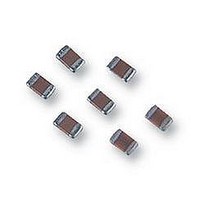GQM1885C2A3R3BB01D Murata, GQM1885C2A3R3BB01D Datasheet - Page 25

GQM1885C2A3R3BB01D
Manufacturer Part Number
GQM1885C2A3R3BB01D
Description
CAPACITOR, NP0, 0603, 3.3PF
Manufacturer
Murata
Series
GQMr
Datasheet
1.GQM1885C2A3R9BB01D.pdf
(30 pages)
Specifications of GQM1885C2A3R3BB01D
Capacitance
3.3pF
Capacitance Tolerance
± 0.1pF
Voltage Rating
100VDC
Capacitor Dielectric Type
Ceramic Multi-Layer
Capacitor Case Style
0603
No. Of Pins
2
Lead Spacing
0.5mm
Operating Temperature
RoHS Compliant
Operating Temperature Range
-55°C To +125°C
Svhc
No SVHC (15-Dec-2010)
Rohs Compliant
Yes
Tolerance
0.1 pF
Temperature Coefficient / Code
C0G (NP0)
Package / Case
0603 (1608 metric)
Product
Low ESR MLCCs
Dimensions
0.8 mm W x 1.6 mm L x 0.8 mm H
Termination Style
SMD/SMT
Lead Free Status / Rohs Status
Details
Available stocks
Company
Part Number
Manufacturer
Quantity
Price
Company:
Part Number:
GQM1885C2A3R3BB01D
Manufacturer:
MURATA
Quantity:
640 000
44 – Innovator in Electronics
Application Specific Capacitors
High Frequency Ceramic Capacitors – GQM Series
GQM Soldering and Mounting
3. Reflow Soldering
Table 1
Recommended Conditions
Peak Temperature
Pb-Sn Solder: Sn-37Pb
Lead Free Solder: Sn-3.0Ag-0.5Cu
When sudden heat is applied to the components, the
mechanical strength of the components should go down
because remarkable temperature change causes
deformity inside components. In order to prevent
mechanical damage in the components, preheating should
be required for both of the components and the PCB board.
Preheating conditions are shown in Table 1. It is required to
keep temperature differential between the soldering and
Optimum Solder Amount for Reflow Soldering
Inverting the PCB
the components surface (∆T) as small as possible.
Solderability of Tin plating termination chip might be
deteriorated when
peak solder temperature is below the Tin melting point is
used. Please confirm the solderability of Tin plating
termination chip before use.
When components are immersed in solvent after mounting,
be sure to maintain the temperature difference (∆T)
between the component and
shown in the Table 1.
Make sure not to impose an abnormal mechanical shock on
the PCB.
Atmosphere
Continued from the preceding page.
GQM18/21
GQM22
Overly thick application of solder paste results in
Too little solder paste results in a lack of adhesive
Make sure the solder has been applied smoothly to the
excessive fillet height solder.
This makes the chip more susceptible to mechanical
and thermal stress on the board and may cause
the chips to crack
strength on the outer electrode, which may result in
chips breaking loose from the PCB.
end surface to a height of 0.2mm* min.
Part Number
Infrared Reflow
230-250°C
a
Air
low temperature soldering profile where
Pb-Sn Solder
Vapor Reflow
the
230-240°C
Temperature Differential
solvent within the range
Air
∆T 19 °C
∆T 130°C
w
w
w
Lead Free Solder
w
w
0
240-260°C
Air or N
w
w
w
w
.
.
2
m
m
.
m
u
u
u
r
r
*GRM 02/03: 1/3 of Chip Thickness min.
Standard Conditions for Reflow Soldering
Peak Temperature
Peak Temperature
Allowable Soldering Temperature and Time
Optimum Solder Amount for Reflow Soldering
r
a
a
Temperature (°C)
Temperature ( °C)
a
t
t
In case of repeated soldering, the accumulated
soldering time must be within the range shown above.
280
270
260
250
240
230
220
a
a
t
200°C
170°C
150°C
130°C
170°C
150°C
130°C
0
a
.
.
∆T
∆T
c
c
.
Infrared Reflow
Vapor Reflow
c
30
o
o
60-120 seconds 30-60 seconds
60-120 seconds
o
Preheating
Preheating
m
m
m
60
Continued on the following page.
Soldering
20 seconds max.
Soldering
Soldering Time (sec.)
90
Gradual
Cooling
Gradual
Cooling
Time
Time
0.2mm* min.
120
C-29-C












